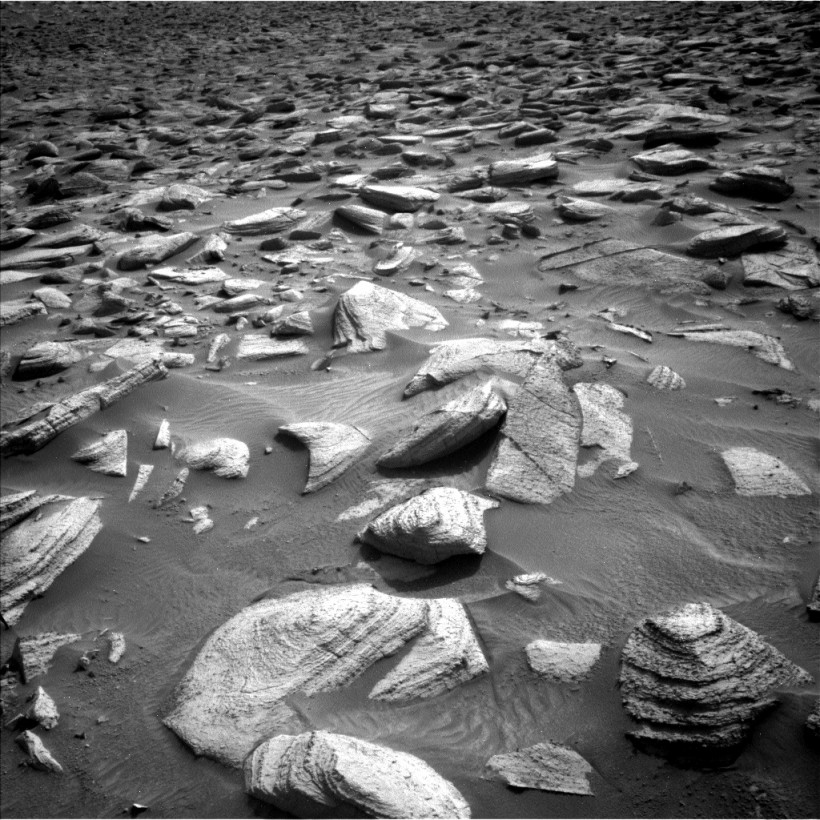During its routine tasks of exploring and capturing images on the planet's surface, NASA's Curiosity Mars rover stumbled upon a rock resembling the delta-shaped Starfleet logo from "Star Trek" on January 9.
The recognizable symbol was included in a collection of Curiosity images, with its data description specifying that it was captured using the rover's left navigation camera, as highlighted by CalTech and NASA's Jet Propulsion Laboratory.

This image was taken by Left Navigation Camera onboard NASA's Mars rover Curiosity on Sol 4062 (2024-01-09 21:08:59 UTC).
Starfleet Logo-Like Rock on Mars
In an amusing discovery, NASA's Curiosity rover captured the delta-shaped symbol associated with Starfleet officers' uniforms and emerged in the likeness of a Mars rock. Curiosity captured the images as it prepared for "contact science on a flat block of dark-toned bedrock," as stated in a January 9 mission blog update.
Though suggesting a Starfleet landing party would be illogical, enthusiasts found humor in the uncanny resemblance. Amateur astronomer Scott Atkinson shared the find on social media, playfully pondering the reactions of the Mars Curiosity team.
This cosmic coincidence follows a pattern of peculiar Martian rocks making headlines. Last summer, NASA's Perseverance Rover, designed for an explicit mission of seeking signs of life, encountered a perplexing donut-shaped rock.
Experts debated its origin, uncertain whether it hailed from Mars or space. In contrast, the more recent "Starfleet"-esque rock discovered by Curiosity appears mundane, highlighting the whimsical nature of Martian geology.
Arizona State University space researcher Jim Rice, discussing the donut-shaped rock, emphasized the region's prevalence of rocks with hollowed-out interiors, casting doubt on the meteorite hypothesis. The comparison underscores the relative normalcy of the "Starfleet" rock, whose charm lies in its delightful resemblance to the iconic symbol from the world of "Star Trek."
READ ALSO: NASA's Perseverance Rover Spots Avocado-Shaped Rock on Mars: A Quirky Find With Geological Insights
NASA Curiosity Rover Continues Its Mission on Mars
Since its arrival on Mars on August 5, 2012, Curiosity has tirelessly pursued its mission to uncover the environmental conditions that could support life on the Red Planet. A key facet of its extended exploration involves ascending Mount Sharp, or Aeolis Mons, analyzing the stratified layers to decode Mars' ancient hydrological history.
The diverse layers of Mount Sharp serve as chronological markers, each reflecting distinct periods in Martian history. As Curiosity progresses upward, scientists gain invaluable insights into the transformative processes that shaped Mars' landscape over millennia.
In a noteworthy development reported by JPL officials in September 2023, the rover has entered a sulfate-rich zone, potentially representing the highest elevation layer it will investigate during its mission.
Continuing its mission, Curiosity is poised to scrutinize the "composition and texture of the dark bands observed from orbit" within the rocks, employing a range of instruments for a comprehensive examination. This strategic analysis aims to deepen our comprehension of the geological features encountered and their significance within the broader Martian landscape.
Curiosity's successes at Gale Crater paved the way for NASA's subsequent rover mission, Perseverance, which landed in the Jezero Crater on Mars in 2020. Perseverance carries the torch forward, actively searching for signs of ancient Martian life.
Meanwhile, NASA is preparing for a Mars sample return mission, building on the groundwork laid by Perseverance to collect rock samples. However, challenges in funding and technology may delay the envisioned return to Earth, currently targeted for 2031.
RELATED ARTICLE: Book Rock? NASA Curiosity Rover Finds Stone Over Martian Surface That Resembles Paperback Shape
Check out more news and information on Space in Science Times.



![Earth's Quasi-Moon Kamo‘oalewa Could Originate From Lunar Surface Not Asteroid Belt [Study]](https://1721181113.rsc.cdn77.org/data/thumbs/full/53275/89/56/50/40/earths-quasi-moon-kamo-oalewa-could-originate-from-lunar-surface-not-asteroid-belt-study.png)










